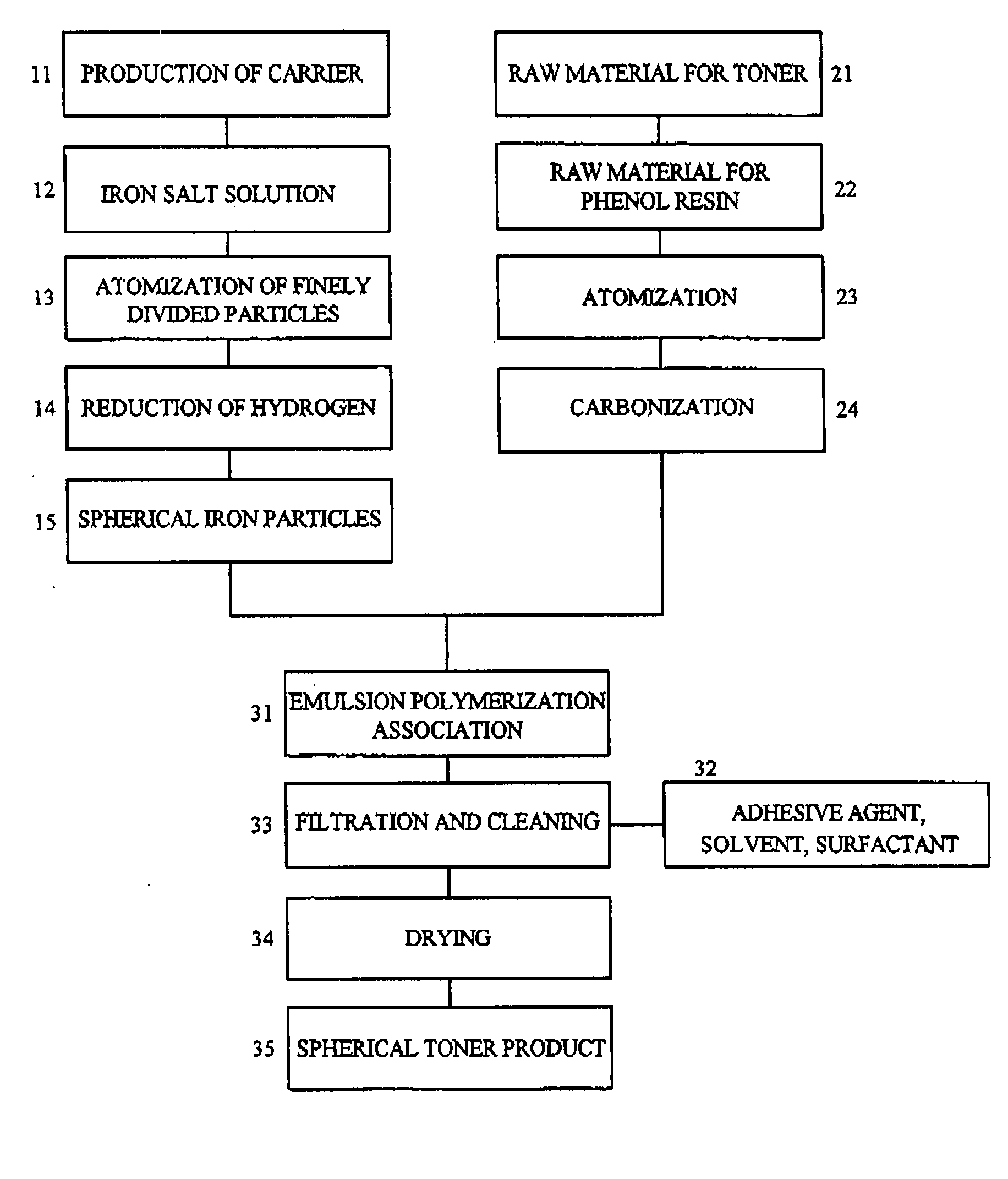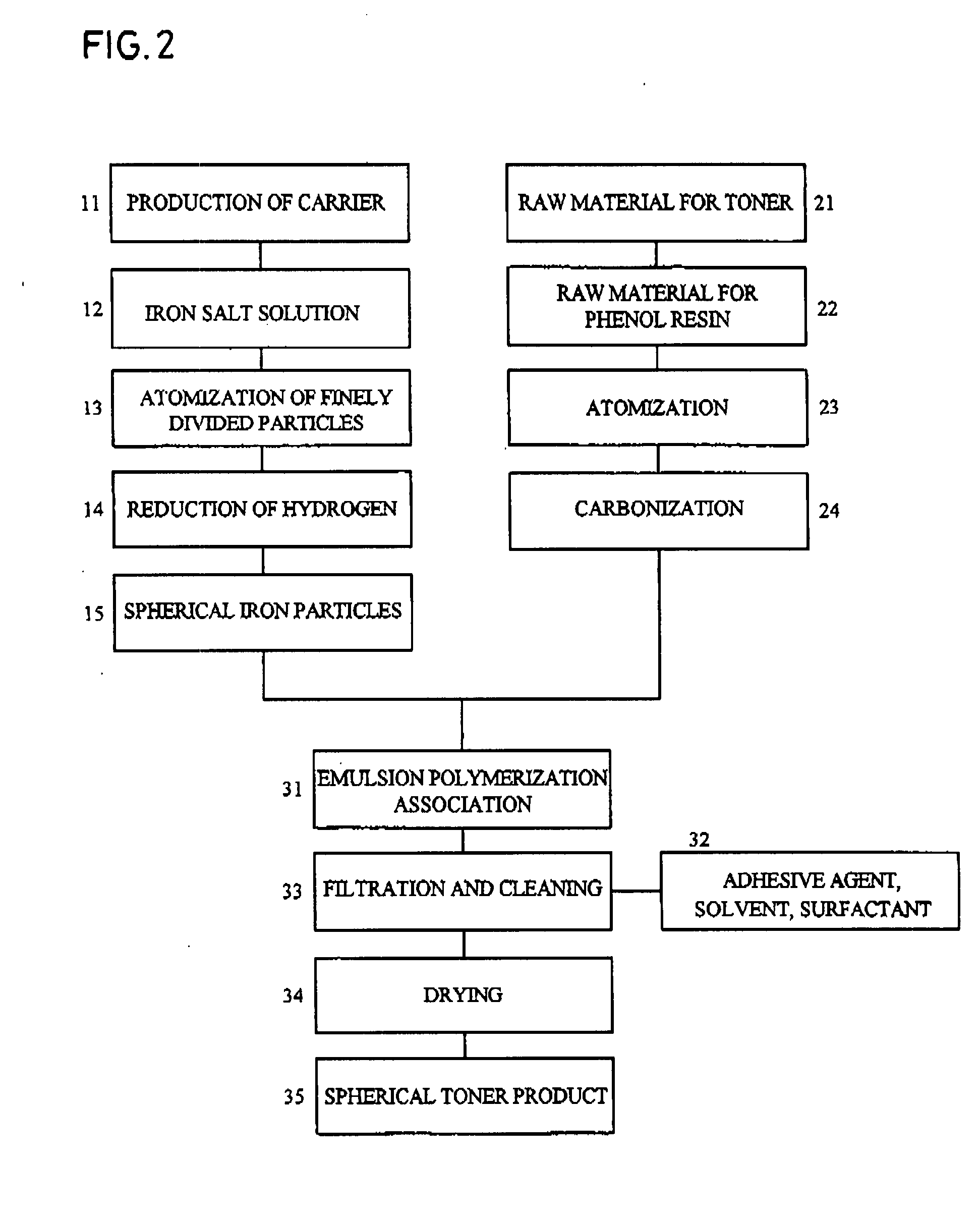Spherical Ultrafine Particles and Process for Producing the Same
a technology of spherical particles and ultrafine particles, which is applied in the direction of synthetic resin layered products, chemical/physical processes, natural mineral layered products, etc., can solve the problems of nozzle method suffering severe wear and corrosion of nozzles, complex process methods, etc., and achieves high efficiency and low cost. , the effect of abounding in commercial valu
- Summary
- Abstract
- Description
- Claims
- Application Information
AI Technical Summary
Benefits of technology
Problems solved by technology
Method used
Image
Examples
example 1
Method for Production of Electrochemical Activated Carbon
[0037]The electrochemical activated carbon is being used in large quantities for air wet cells and electrical double layer capacitors. First, the activated carbon for use in the electrical double layer capacitors that have been highlighted recently will be described in detail below.
[0038]The electrical double layer capacitors now on sale are known in two types, i.e. the coin type that is produced as illustrated in FIG. 1 and disclosed in JP-B HEI 2-13453, a prior application by the present inventors, by causing an element resulting from nipping a separator 3 between a pair of polarized electrodes 1 comprising a powdered activated carbon possessing a high specific surface area as a main component on a current collector 2 formed of etching aluminum foil to be sealed together with an electrolytic solution 4 in a metallic case with the cap of the metallic case, a metallic rid 5 thereof and a gasket 6 insulating them from each othe...
example 2
Printer-Oriented Toner
[0051]The conventional printer-oriented toner has been produced in the basic configuration having comminuted carbon particles about 1 μm˜10 μm in diameter adhere to the surface of the comminuted iron particles measuring about 100 μm in diameter and serving as a carrier via an adhesive agent. This method is at a disadvantage in revealing deficiency in the yield of production of the spherical particles of iron powder, suffering the produced comminuted carbon particles to occupy a large particle size distribution of 1˜10 μm, failing to impart a spherical shape to the produced particles, incurring difficulty in uniformly coating the surface of iron power with the dyestuff, betraying inferiority of yield of production and consequently suffering the toner to become expensive.
[0052]In recent years with regard to printers, the demand for enhancing definition, adding to speed, saving energy and reducing the waiting time has been gaining in strictness and the technologic...
example 3
Method for Producing Spherical Porous Silica
[0057]The conventional technique implements this production by subjecting alkali-excess molten glass to the spray method at an elevated temperature in the range of 700° C.˜900° C. as described above. This conventional method has entailed various problems, such as entailing corrosion of the nozzle due to the high temperature and the presence of strong alkali, lacking uniformity of particle size distribution, requiring high cost of production and revealing unduly low yield of fine particles not more than 100 μm in diameter.
[0058]In recent years, the demand for ultrafine particulate porous silica having a particle diameter in the range of 0.1 μm˜10 μm has been prevailing. The demand for filters used for separation of coagulated protein during the production of beer, undercoats used for protecting automobiles and household appliances from corrosion and carriers used for medicines and catalysts has been mon , and the demand has been directed to...
PUM
| Property | Measurement | Unit |
|---|---|---|
| Length | aaaaa | aaaaa |
| Length | aaaaa | aaaaa |
| Length | aaaaa | aaaaa |
Abstract
Description
Claims
Application Information
 Login to View More
Login to View More - R&D
- Intellectual Property
- Life Sciences
- Materials
- Tech Scout
- Unparalleled Data Quality
- Higher Quality Content
- 60% Fewer Hallucinations
Browse by: Latest US Patents, China's latest patents, Technical Efficacy Thesaurus, Application Domain, Technology Topic, Popular Technical Reports.
© 2025 PatSnap. All rights reserved.Legal|Privacy policy|Modern Slavery Act Transparency Statement|Sitemap|About US| Contact US: help@patsnap.com



